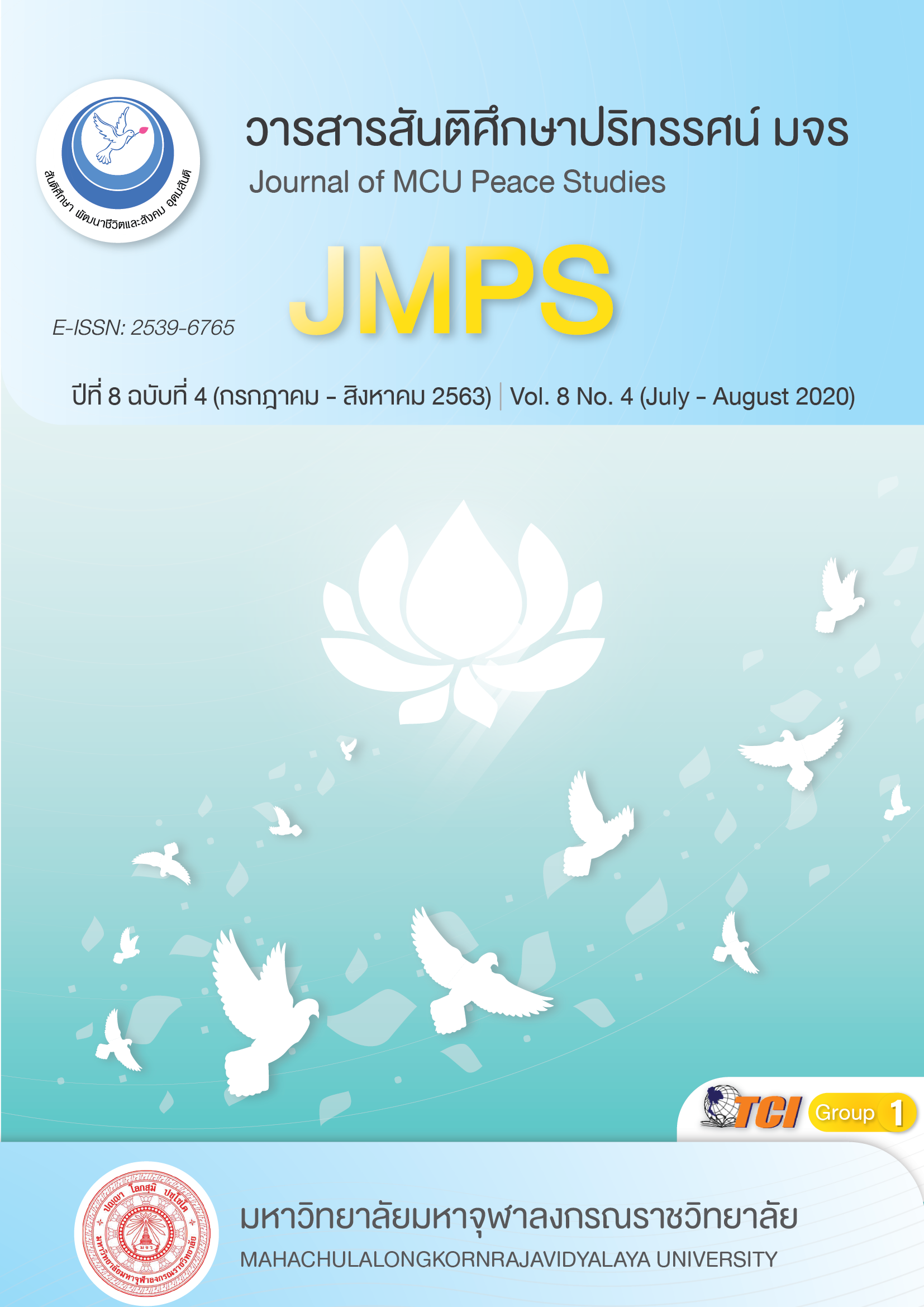บทวิเคราะห์รูปแบบการปลูกฝังศีลธรรมแก่เยาวชนไทยบนสังคมออนไลน์
Main Article Content
บทคัดย่อ
บทความวิชาการว่าด้วย “บทวิเคราะห์รูปแบบการปลูกฝังศีลธรรมแก่เยาวชนไทยบนสังคมออนไลน์” เป็นการวิเคราะห์รูปแบบการปลูกฝังศีลธรรมแก่เยาวชนไทยบนสังคมออนไลน์ และแนวทางการเสนอแนะการพัฒนารูปแบบการปลูกฝังศีลธรรมแก่เยาวชนไทยบนสังคมออนไลน์ให้มีความน่าสนใจ และชวนติดตามของเยาวชนไทยเพื่อป้องกันปัญหาในทางสังคม เช่น ปัญหายาเสพติด ปัญหาโรคติดต่อทางเพศ ปัญหาความก้าวร้าว ปัญหาความหมกมุ่นในเรื่องเพศ ปัญหาการทะเลาะวิวาท เป็นต้น อันเป็นปัญหาที่ส่งผลกระทบต่อสังคม ดังนั้น การปลูกฝังศีลธรรมในศตวรรษที่ 21 จึงต้องมีความน่าสนใจ และสามารถโน้มน้าวเยาวชนให้มีพฤติกรรมที่ดีงาม เพื่อเติบโตเป็นผู้ใหญ่ที่ดีในอนาคตอย่างมีประสิทธิภาพ ในระบบสังคมออนไลน์ มีรูปแบบการเผยแผ่มากมาย เช่น รูปแบบการโพสต์ภาพที่มีการตัดต่อที่เหมาะสม รูปแบบการทำคลิปวิดีโอธรรมะเตือนสติแบบสั้นๆ และแบบยาว โดยแบบยาวจะเป็นรูปแบบการนำเสนอธรรมะแบบเฮฮา รูปแบบธรรมะของพระสายพระป่า รูปแบบธรรมะที่เป็นวิชาการ และรูปแบบไลฟ์สด ทุกรูปแบบจะถูกแชร์บนแอพพลิเคเฟซบุ๊คอันเป็นแอพพลิเคชันยอดนิยมที่มีกลุ่มเยาวชนใช้อย่างหลากหลาย โดยมีเนื้อหาสาระ เช่น พุทธศาสนสุภาษิต สุภาษิต คำสอนของครูบาอาจารย์สายวัดป่า คำกลอน คติพจน์ เป็นต้น ซึ่งการจะทำให้เยาวชนติดตามธรรมะและปฏิบัติตนเป็นคนดีอย่างต่อเนื่อง จำเป็นอย่างยิ่งที่จะต้องจัดทำสื่อการสอนธรรมะในรูปที่น่าสนใจมากขึ้น โดยมีรางวัลตอบแทนการตอบธรรมะเป็นทุนการศึกษาหรืออุปกรณ์การเรียนเป็นต้น ก็จะทำให้เยาวชนตื่นตัวที่จะศึกษาธรรมะอย่างจริงจัง
Article Details
ทัศนะและความคิดเห็นที่ปรากฏในบทความในวารสาร ถือเป็นความรับผิดชอบของผู้เขียนบทความนั้น และไม่ถือเป็นทัศนะและความรับผิดชอบของกองบรรณาธิการ ยินยอมว่าบทความเป็นลิขสิทธิ์ของวารสาร
เอกสารอ้างอิง
Anholt, S. (2006). The Anholt-GMI city brands index: how the world sees the world’s cities. Place Branding and Branding. 2(1), 18-31.
Bhatta, C. (2016). The Interface between the Sate and Civil Society in Nepal. Dhaulagiri Journal of Sociology and Anthropology. 10, 63-91.
Dayle R. Jesse. (2015). Smartphone and App Usage Among College Students: Using Smartphones Effectively for Social and Educational Needs. Proceedings of the EDSIG Conference. Conference on Information Systems and Computing Education Wilmingto, North Carolina USA.
Kaur, Anuprinya & Medury, Y. (2011). Impact of the internet on teenagers’ influence on family purchases. Young Consumers insight and Ideas for Responsible Marketers. 12(1), 27-38.
Kira, E, & Komba, S. (2015). Integrating Moral and Ethical Values in the General Studies Syllabus at Advanced Level Secondary School in Tanzania: Challenges and Opportunities. Research Journal of Education. 1(3), 21-26.
Kohlberg, L., & Lickona, T. (Eds) (1976). “Moral Stages and Moralization: The CognitiveDevelopmental Approach” Moral Development and Behavior Theory, Research and Social Issues. Holt, NY: Rinehart and Winston.
Mahaarch, W., & Kttisuksathit, S. (2007). Thai Youth Happiness: Evidences from Kanchanaburi Province. International Conference on “Happiness and Public Policy”. Organized by Public Policy Development Office (PPDO).
Naksakul, K. (2015). Determination of Youth Age. Office of the Royal Society. Bangkok: Office of the Royal Society. United Nation. (2016). Youth: Realities and Challenges for Achieving Development with Equality. Santiago: United Nations.
Phrakrusunthornsangkhapinit, & Phrakhrubhaitighaatippanangorn. (2015). Propagating Buddhism in the Digital Age. Jouranl of Buddhist Education and Research. 1(2), 8-20.
Phrakruuthesasutaporn. (2015). Morality for Thai Youth Development. Journal of Graduate Review. 3(3), 1-17.
Phramahasomchai Klinchan, Prarob Kaewses, & Phrarachworamethee. (2016). The Propagation of Buddhism: The Development of Format and Method of Approached Strategy of Thai Sangha. Journal of MCU Social Science. 5(1), 205-216.
Phramedhavinaiyaros, Phramahaviroj, PhramahaSurasak, & Salinee Raggatanyoo. (2019). The model of Propagation of Buddhism for People in the Twenty-sixth Buddhist Century to Promote the Permanence of Buddhist. Journal of MCU Social Science. 8(4), 17-33.
Piaget, J. (1956). The origins of intelligence in children. (M. Cook, Trans.). NY: International University Press.
Robinson, J. (2017). Measures for Communication Behavior Buddhist Monks of Globalization Society in Thailand. Proceeding of the 17th Graduate Studies of Northern Rajabhat University Network Conference. 1593-1600.
Sagarik, D, Chansukree, P, Cho, W & Berman E. (2018). E-government 4.0 in Thailand: the role of central agencies. Information Policy. 23, 343-353.
Sharma, S. (2013). Teacher: A Social Engineer and New Directions for the 21st Century Teachers. Scholarly Research Journal for Humanity Science & English Language. 1(1), 147-153.
Shihab, H. (2011). Effect of Internet Drawbacks on Moral and Social Values of Users in Education Australian. Journal of Basic and Applied Sciences. 5(6), 372-380.
Steinberg, L. (1996). Adolescence. New York: McGraw-Hill Inc. Tangpatomwong, T. (2017). The Right Principle Model in the News Reporting Process of Social Media. Panidhana: Jouranl of Philosophy and Religion. 13(2), 287-314.
Tangmunkongvorakul, A, Kane, R, & Wellings, K. (2005). Gender double standards in young people attending sexual health services in Northern Thailand. Routledge. 7(4), 361-373.
Wipatasinlapin, N. (2017). The Model of Youth Development Project, Samanera Plookpanya Dhamma, Based on the Threefold Training Principles. Journal of International Buddhist Studies. 8(1), 1-22.


